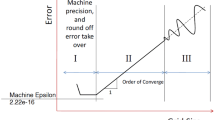Abstract
This paper is concerned with the problem of verification of the numerical accuracy of computed information with particular reference to a model problem in solid mechanics. The basic concepts and procedures are outlined and illustrated by examples.






Similar content being viewed by others
Notes
StressCheck is a trademark of Engineering Software Research and Development, Inc., St. Louis, Missouri, USA.
References
AIAA Editorial Policy Statement on Numerical Accuracy and Experimental Uncertainty (1994) AIAA J 32(1):3
ASME V&V 10-2006 (2006) Guide for verification and validation in computational solid mechanics. The American Society of Mechanical Engineers. ISBN No. 0-7918-3042-X
Szabó B, Actis RL (2009) On the role of hierarchic spaces and models in verification and validation. Comput Methods Appl Mech Eng 198:1273–1280
Pitkäranta J, Babuška I, Szabó B (2008) The Girkmann problem. IACM Expr 22:28
Pitkäranta J, Babuška I, Szabó B (2009) The Problem of Verification with Reference to the Girkmann Problem. IACM Expr 24:14–15
Girkmann K (1956) Flächentragwerke, 4th edn. Springer, Wien
Timoshenko S, Woinowsky-Krieger S (1959) Theory of plates and shells, 2nd edn. McGraw-Hill, New York
Timoshenko S, Goodier JN (1951) Theory of elasticity, 2nd edn. McGraw-Hill, New York
Naghdi PM (1963) Foundations of elastic shell theory. In: Seddon IN, Hill R (eds) Progress in solid mechanics, vol 4. North-Holland, Amsterdam
Novozhilov VV (1964) Thin shell theory. P. Noordhoff Ltd, Groningen
Pitkäranta J The dome and the ring. Manuscript
Destuynder PA (1985) Classification of thin shell theories. Acta Appl Math 4:15–417
Ciarlet PG (1990) Plates and junctions in elastic multi-structures: an asymptotic analysis. RMA, vol 14. Masson, Paris
Szabó B, Babuška I (1991) Finite element analysis. Wiley, New York
Szabó B, Düster A, Rank E (2004) The p-version of the finite element method. In: Stein E, de Borst R, Hughes TJR (eds) Encyclopedia of computational mechanics, Chap, 5, vol 1. Wiley, Chichester
Chen Q, Babuška I (1995) Approximate optimal points for polynomial interpolation of real functions in an interval and in a triangle. Comput Methods Appl Mech Eng 128:405–417
Ainsworth M, Oden JT (2000) A posteriori error estimation in finite element analysis. Wiley, New York
Babuška I, Strouboulis T (2001) The finite element method and its reliability. Oxford University Press, Oxford
Babuška I, Miller A (1984) The post-processing approach in the finite element method—part 1: calculation of displacements, stresses and other higher derivatives of the displacements. Int J Numer Methods Eng 20:1085–1109
Author information
Authors and Affiliations
Corresponding author
Appendix: Proof of inequality (25)
Appendix: Proof of inequality (25)
The function \({\mathbf w}^{({\mathbf M})}\) was defined on ΩS and is extended by zero over Ω. Therefore, \({\mathbf w}^{({\mathbf M})}\) is discontinuous on Γα and it does not lie in E(Ω). In other words, \(\Vert {{\mathbf{w}}}^{({{\mathbf{M}}})}\Vert_{E(\Upomega)}\) has no meaning. On the other hand \(\Vert {{\mathbf{w}}}^{({{\mathbf{M}}})}\Vert_{E(\Upomega_{\rm S})}\) is well defined. We define an auxiliary function \({\mathbf z}_{{\mathbf{EX}}}^{({\mathbf M})}\in E(\Upomega)\) as follows:
where \(B_{\Upomega_{\rm S}}({{\mathbf{w}}}^{({{\mathbf{M}}})},{{\mathbf{v}}})\) is a bounded functional on E(Ω). This guarantees that the function \({\mathbf{z}}_{{\mathbf{EX}}}^{({\mathbf{M}})}\,{\in}\,E(\Upomega)\) exists. The function \({\mathbf z}_{{\mathbf{EX}}}^{({\mathbf M})}\) is uniquely determined up to rigid body displacement in the axial direction. It is continuous and smooth on Ω. By selecting v = u EX − u FE , Eq. (23) can be written as:
Next we define \({\mathbf z}_{{\mathbf FE}}^{({\mathbf M})}\,{\in}\,S(\Upomega)\) as follows:
The function \({\mathbf z}_{{\mathbf{FE}}}^{({\mathbf M})}\) is the projection of \({\mathbf z}_{{\mathbf{EX}}}^{({\mathbf M})}\) onto the finite element space S(Ω). By the Galerkin orthogonality:
therefore we can select \({\mathbf v}={\mathbf z}_{{\mathbf FE}}^{({\mathbf M})}\) and divide by R c to obtain:
Upon subtracting Eq. (47) from Eq. (45), we have:
and Eq. (25) follows from the Schwarz inequality.
Remark 8
Owing to the regularity of \({\mathbf z}_{{\mathbf{EX}}}^{({\mathbf M})}\) on Ω the rate of convergence of \({\mathbf z}_{{\mathbf FE}}^{({\mathbf M})}\) is likely to be comparable to the rate of convergence of u FE . Therefore, the error in M (FE)α will be roughly proportional to the square of the error in energy norm, which is the same as the error in strain energy. Note that we have been concerned with an upper estimate of the error in M (FE)α . Under various circumstances the actual error may be much smaller than the upper estimate. Generally speaking, the extraction method is very robust as illustrated by the numerical results presented in this paper.
Rights and permissions
About this article
Cite this article
Szabó, B.A., Babuška, I., Pitkäranta, J. et al. The problem of verification with reference to the Girkmann problem. Engineering with Computers 26, 171–183 (2010). https://doi.org/10.1007/s00366-009-0155-0
Received:
Accepted:
Published:
Issue Date:
DOI: https://doi.org/10.1007/s00366-009-0155-0




